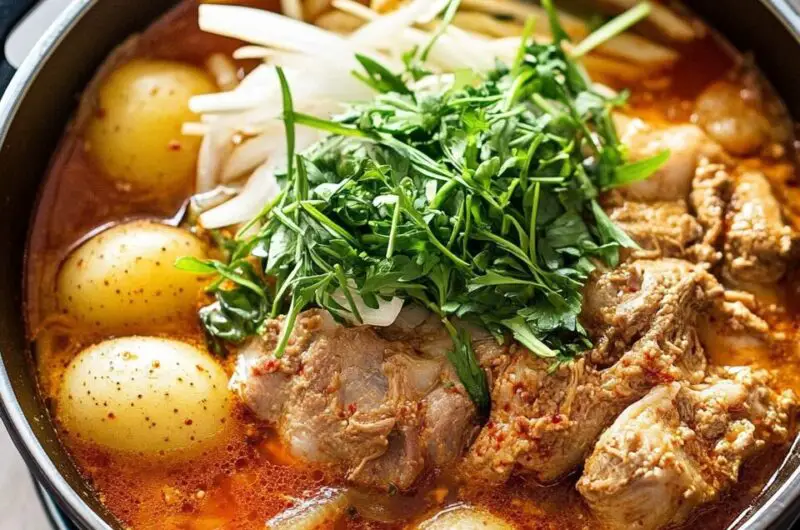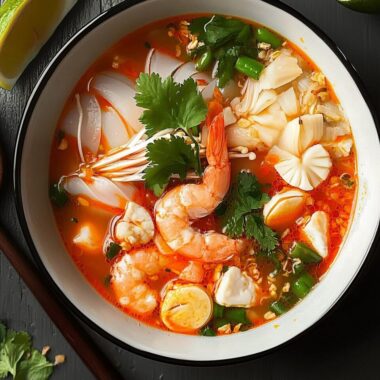Gamjatang, often translated as “potato stew,” is actually a robust Korean pork bone stew brimming with spicy, savory, and deep umami flavors. The simmered bones create a rich bone broth base, while potatoes and cabbage absorb the vibrant seasoning of doenjang and gochujang. Every spoonful is warming comfort, perfect for chilly evenings or gathering around the table with family. What makes this dish truly special is its balance of textures and heat fork-tender pork falls from the bone, chunks of potato soak up the broth, and perilla leaves add an herbaceous finish. It’s a communal meal, best enjoyed with kimchi, rice, or a cold Korean beer to round out the experience.
Full Recipe:
Ingredients:
-
-
2 lbs pork neck bones (or backbone)
-
8 cups water
-
5–6 small potatoes, halved
-
1 onion, quartered
-
4 cloves garlic, smashed
-
1 thumb‑sized piece fresh ginger, sliced
-
2 tablespoons Korean fermented soybean paste (doenjang)
-
2 tablespoons Korean red chili paste (gochujang)
-
1 tablespoon Korean red pepper flakes (gochugaru)
-
2 tablespoons soy sauce
-
1 tablespoon fish sauce
-
1 teaspoon sugar
-
2 scallions, chopped
-
1 cup Napa cabbage, sliced
-
Handful of perilla leaves (optional)
- Salt and pepper to taste
-
Directions:
-
-
Rinse pork bones under cold water. In a large pot, combine bones, water, onion, garlic, and ginger. Bring to a boil, then lower heat and simmer for 1 hour, skimming off foam.
-
Remove bones and strain broth into another pot. Discard solids, return broth, and add pork bones back.
-
Stir in doenjang, gochujang, gochugaru, soy sauce, fish sauce, and sugar. Simmer 20 minutes.
-
Add potatoes and simmer 15 minutes until tender.
-
Stir in Napa cabbage, scallions, perilla leaves if using. Cook another 5 minutes.
-
Taste and adjust salt or pepper as needed.
-
-
Prep Time: 20 minutes | Cooking Time: 1 hour 40 minutes | Total Time: 2 hours | Kcal: ~420 kcal per serving | Servings: 4
Exploring Gamjatang: Korea’s Bold and Comforting Pork Bone Soup
Gamjatang (감자탕), often referred to as Korean Pork Bone Soup, is one of Korea’s most beloved comfort foods. This deep, hearty stew is known for its robust flavor profile, complex layering of spice and umami, and its capacity to warm the soul on the chilliest of days. Traditionally made with meaty pork neck or spine bones and simmered for hours, this dish yields a rich, milky broth infused with aromatics and chili spice. It’s typically served bubbling hot with potatoes, napa cabbage, and garnished with unique herbs like perilla leaves or crown daisy.
Gamjatang is a cornerstone of Korean soul food. It is a dish steeped in cultural tradition, and every spoonful tells a story of culinary heritage, resourcefulness, and communal dining. While it’s widely enjoyed across Korea, it also continues to gain popularity worldwide for its intense flavors and deeply satisfying texture.
Origins and Historical Context
The name “Gamjatang” may be confusing to some, as “gamja” (감자) typically translates to “potato” in Korean. Interestingly, some scholars believe that the original term may have referred not to potatoes, but to a part of the pig’s spine. Regardless of the origin, potatoes became a staple part of the dish and now coexist with bone-in pork as defining ingredients.
Gamjatang originated in southern Korean provinces, particularly in areas where agriculture and pig farming were common. In earlier times, pork was not as widely consumed in Korea as beef due to economic and religious reasons. When pork was available, families would make the most of it, using all parts of the pig particularly the bones to make nourishing broths. Over time, this practice evolved into a more elaborate and spicy stew, influenced by local ingredients such as fermented soybean paste (doenjang), Korean red chili flakes (gochugaru), and wild sesame seeds.
This dish has also been closely tied to workers’ diets, especially among manual laborers, due to its affordability and ability to provide sustained energy and warmth.
Flavor Profile and What Makes It Special
Gamjatang is not your average bone soup. Its signature richness comes from the long simmering of pork bones, which releases collagen and marrow into the broth, giving it a creamy, milky appearance. This depth is then elevated by the use of fermented ingredients like doenjang and gochujang (fermented chili paste), which add umami and spice.
The use of gochugaru introduces a smoky, fruity heat that isn’t overwhelming but builds slowly, offering a complex flavor rather than just sharp spiciness. The addition of vegetables like napa cabbage, mung bean sprouts, and potatoes brings balance, freshness, and variety in texture.
Perilla seeds or toasted sesame seeds are often ground and stirred into the soup just before serving, giving it a nutty undertone and thickened consistency that is uniquely Korean. For those unfamiliar, this element is both surprising and addictive.
Nutritional Benefits
Gamjatang, while indulgent in flavor, is also surprisingly nutritious. The pork bones provide a natural source of collagen, gelatin, and calcium, all of which are beneficial for joint and bone health. The fermentation in ingredients like gochujang and doenjang supports gut health with probiotics, and the vegetables add fiber, antioxidants, and vitamins.
Unlike many other stews that rely on heavy oils or butter, Gamjatang is relatively low in unhealthy fats if properly skimmed, yet incredibly satisfying due to the hearty ingredients and spicy kick.
Cultural Significance
In Korea, Gamjatang is more than a meal it’s an experience. It is often shared communally at the table in a large pot placed over a burner, keeping it hot throughout the meal. This method of eating fosters conversation and bonding. It’s common to see people in Korea enjoying gamjatang late at night, after a round of drinks with friends, or during cold winters with family members gathered close.
The dish also plays a role in Korean hangover culture. Like many spicy Korean soups, it is believed to help with alcohol detox and to rehydrate and re-energize after a night of drinking. Hence, it’s frequently served in restaurants that stay open late or offer 24-hour service.
Regional and Modern Variations
While the traditional Gamjatang remains a staple, various regions and restaurants have developed their own twists. Some versions are spicier, while others add more vegetables or even instant noodles toward the end for extra heartiness. In urban centers, you may find deluxe gamjatang with extra meaty bones, or even versions with cheese for a fusion take.
Vegetarians and vegans have also found ways to adapt the flavors of gamjatang using plant-based broths, tofu, and fermented soybean products, proving the versatility of the dish.
Cooking Tips and Serving Suggestions
For those preparing Gamjatang at home, patience is key. The bones must be thoroughly cleaned and pre-boiled to remove impurities. A long simmer is essential for drawing out the marrow and developing flavor. If you want to enhance the experience, serve the soup with hot steamed rice, kimchi, and perhaps a simple side of pickled radish or cucumber salad.
Using a dolsot (Korean stone pot) or cast iron pot can help retain heat and provide an authentic feel. For leftovers, the flavors deepen even more the next day, making it a perfect meal prep option for busy households.
Why Gamjatang is a Must-Try
If you’re looking to explore authentic Korean cuisine beyond BBQ and bibimbap, Gamjatang offers a soulful, spicy, and deeply nourishing option. It’s not just a dish it’s a comforting ritual that brings warmth, conversation, and culture to the table.
Whether you’re new to Korean food or already a fan of its spicy stews, Gamjatang is a dish that deserves a permanent spot in your culinary rotation. From its nutritious ingredients to its cultural roots, every bowl tells a story of Korean resilience, community, and the power of flavor.
Conclusion:
Gamjatang stands out as one of Korea’s most iconic dishes, thanks to its layered flavor, comforting texture, and communal dining experience. Rooted in tradition and adaptable to modern tastes, this pork bone soup remains a cherished part of Korea’s culinary heritage.
Its preparation may take time, but the result is a bowl of nourishment that warms both body and soul. For food enthusiasts, home cooks, and cultural explorers alike, Gamjatang is more than just a recipe it’s a journey into the heart of Korean cuisine. So next time you’re craving something bold, warming, and satisfying, let this stew be your go-to comfort dish.








